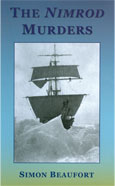 A grisly murder on a hot, sultry night in July 1907. Could it be that someone does not want Ernest Shackleton and his expedition to set sail for the Antarctic?
A grisly murder on a hot, sultry night in July 1907. Could it be that someone does not want Ernest Shackleton and his expedition to set sail for the Antarctic?
On 30 July 1907, members of the British Antarctic Expedition, led by Ernest Shackleton, sailed down the Thames on the tiny, refurbished sealer Nimrod. Some six months later, in February 1908, the expedition landed in Antarctica.
At Cape Royds, Shackleton and his companions built a hut and set up camp. They then began their long wait for the following spring, when Shackleton would head into the icy unknown in an attempt to become the first man ever to reach the South Pole. In the worldwide fame and glory that followed the return of Shackleton’s party to civilisation, little was ever said about a dark incident that almost halted the expedition before it had even sailed.
On the eve of the departure of Nimrod to the Antarctic, the body of the assistant biologist was found in the East India Docks. Without a doubt he had been murdered.
Raymond Priestley, just short of his 21st birthday, had been appointed expedition geologist and was one of the first on the scene. Now it fell to him to undertake an investigation, along with Inspector William Taylor, an old school friend of Shackleton’s, into the events surrounding this dark deed. Priestley had no knowledge of the danger into which he would soon be plunged.
Amazon.co.ukHardcoverWaterstonesErskine Press
Amazon.com
Extract
Taylor dismissed them and leaned back in the chair, staring through the porthole to a dismal view across the Blackwall Railway Terminus and the skeletal cranes that stood sentinel along the filth-strewn banks of the Thames. He glanced at his pocket watch and wondered why Inspector Andrews was taking so long to arrive. The man was not usually tardy. He began to wonder if Shackleton had been right, and Chief Superintendent Hamilton had interfered with his detectives’ rota.
He reviewed what he had learned so far. It was not yet known what time Scudder had died, but the biologist had probably left Eaton Square before ten, and was dead by quarter past two, when he was discovered by First Officer Davis. The murder weapon was a letter opener of the kind favoured by officers who had served in the Royal Naval Reserve, and there were four men who might own one: Shackleton, Captain England, Adams and Mackay. All would need to provide alibis.
Taylor considered the facts, and was inclined to think that the killer had wanted one thing: Scudder dead. Scudder may have been slightly drunk, which perhaps accounted for the lack of defensive wounds, but Taylor guessed it more likely that he had known his assailant, and had not considered himself to be in danger. The killer had been able to come close to him, and then drive the blade clean through his neck.
It was a very personal way to kill, necessitating the killer to stand close to his victim when he delivered the fatal blow. Did that mean it was a crime of hate? Taylor’s experience told him that a common robber would have been more likely to have stabbed Scudder in the back, not driven a knife through his neck in such a bizarre manner. Marshall had claimed that Adams was the ‘murdering kind,’ whatever that meant. But, as a policeman, Taylor knew that any man could be the ‘murdering kind’ given the right circumstances. Of course, it was also Adams who had sent the watchmen off to the eastern end of the quay, far from where the murder had taken place.
Taylor also knew the victim had not been popular, although Priestley was unwilling to say anything unpleasant and Shackleton had not considered Scudder abrasive enough to cause conflict. However, Marshall had clearly detested him, while someone had disliked him enough to damage his nets and perhaps do something to the loading hatch to prevent the Monagasque trawl from being stowed according to plan. Could the latter have been a ploy to ensure Scudder’s later appearance at the dock? Taylor thought it a definite possibility.
Then there were others who had reason to want the victim out of the way: the three ‘hopefuls’ seemed dependent on his good will in order to be selected for the expedition, but it was clear the victim had not been easy to please. And one of them – Yaxley – had had a public argument with Scudder. Had he been afraid that the row had spoiled his chances, so had taken steps to ensure Scudder was not in a position to do him harm? Meanwhile, O’Brien, whom Scudder had apparently liked, was considered by Shackleton ‘not the right fit’ for reasons the Boss did not understand himself. Then the awful possibility crossed Taylor’s mind that Shackleton might have seen Scudder as an impediment to the smooth running of his venture, and regretted the appointment.
But no. Taylor had been friends with Shackleton for a long time, and even if Scudder had become a problem, no aspect of the scientific programme was worth risking the goal Shackleton had been intent on ever since he had returned from Scott’s expedition four years before – the attainment of the Pole. Taylor dismissed Shackleton as a suspect: one of his staff might have made an end to an unpopular colleague, but Shackleton would have had nothing to do with it. Or would he?

